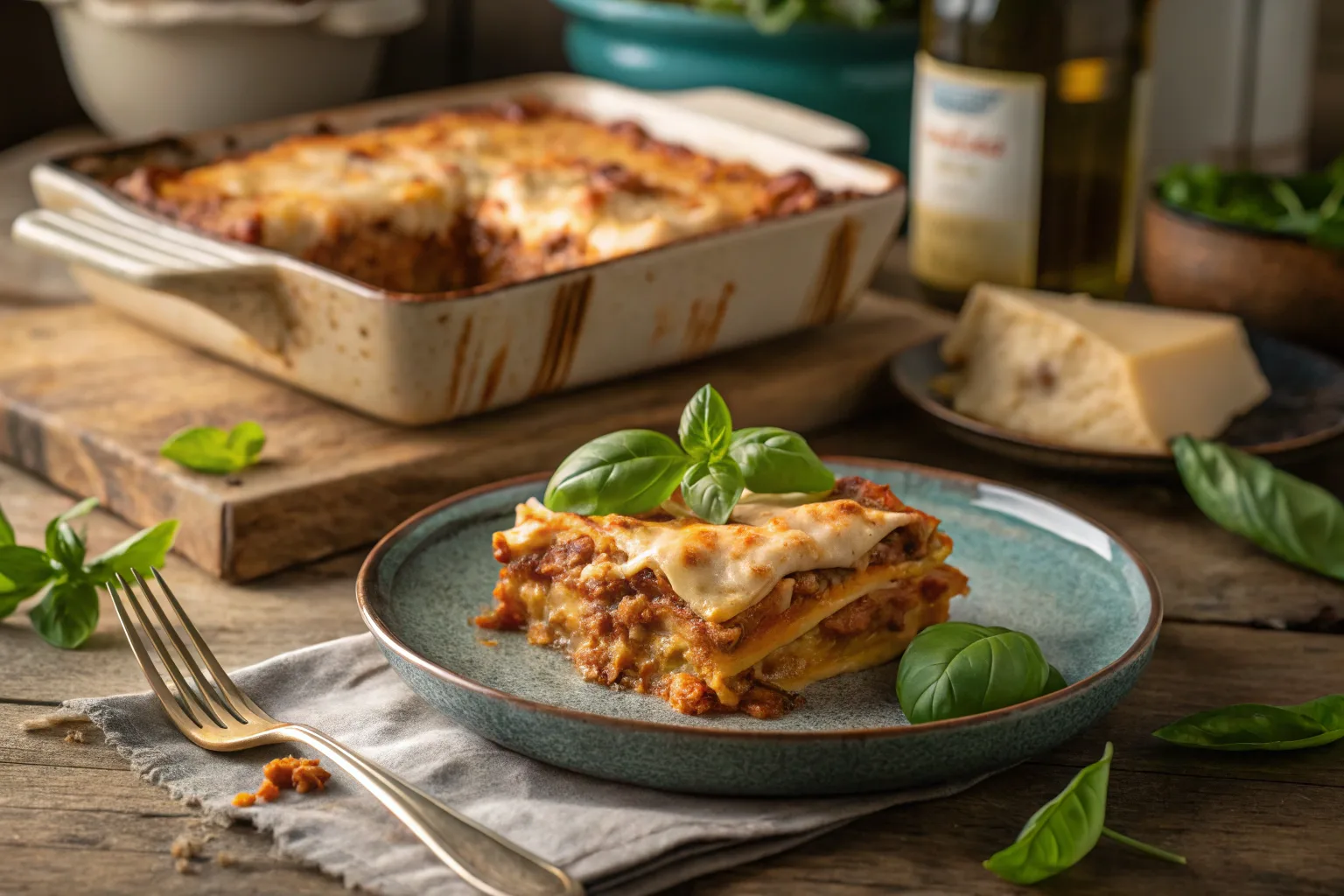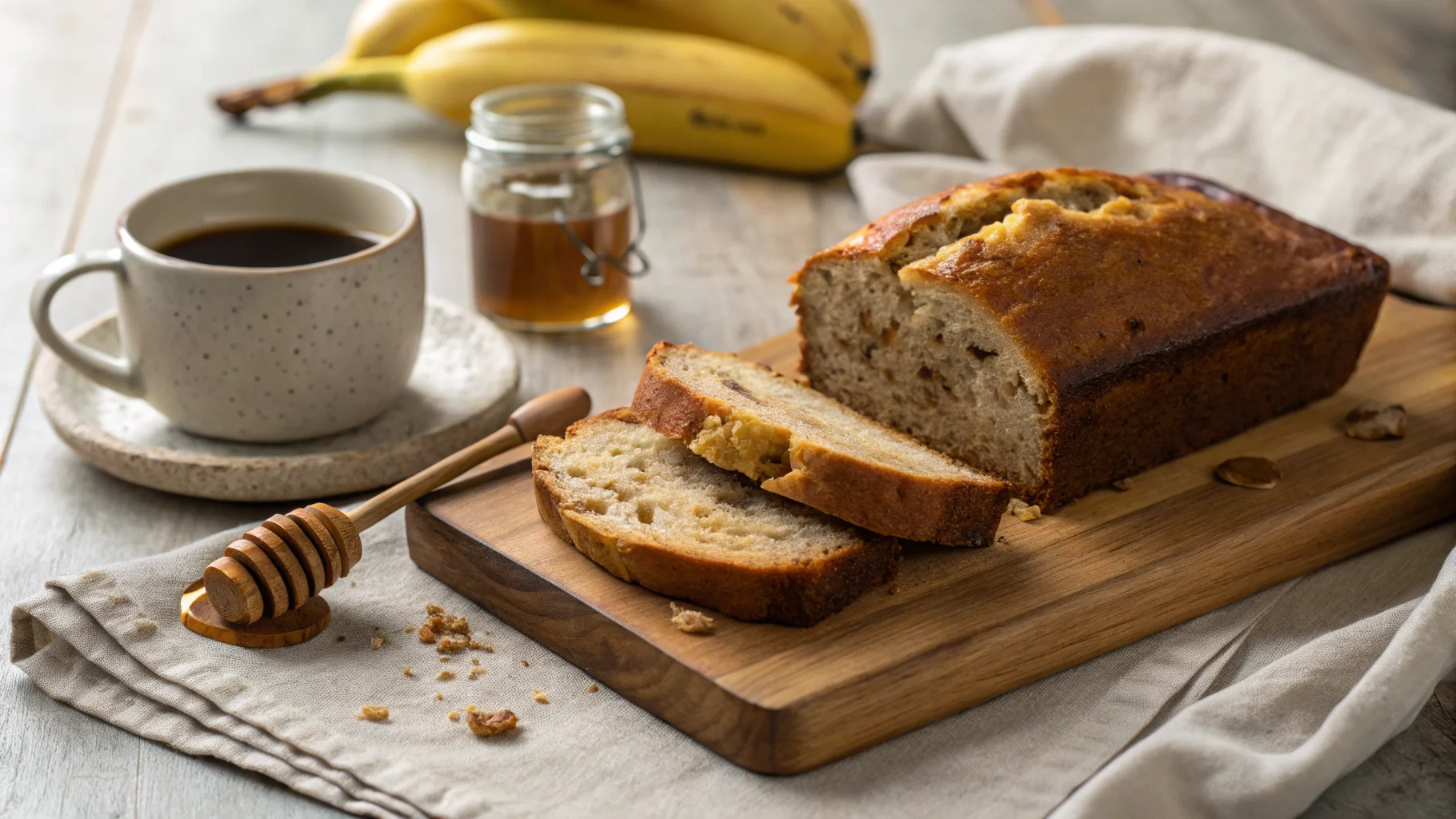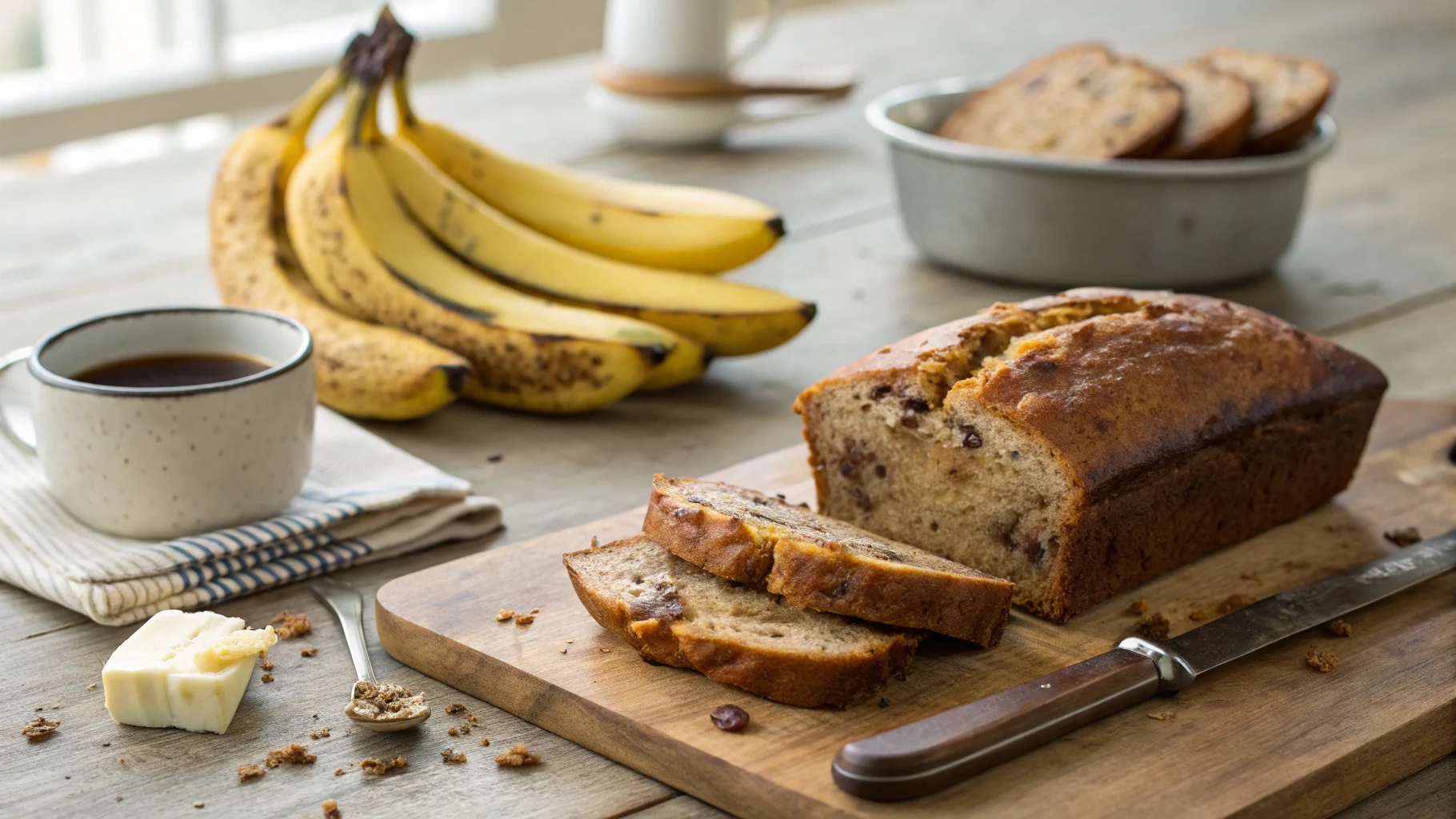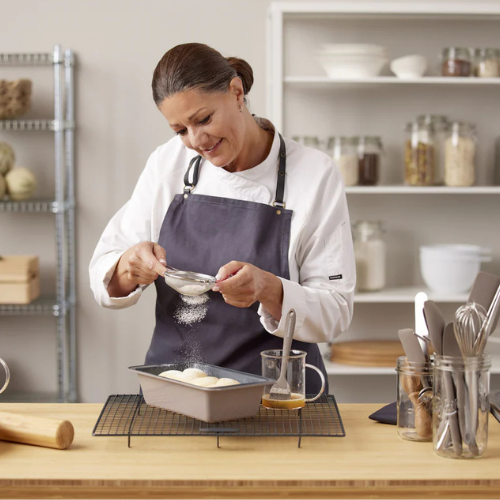Introduction
Lasagna is one of those dishes that feels like a warm hug. Whether you’re making it for a family dinner or prepping for a week of leftovers, nothing beats a homemadeMini pasta recipes But let’s be honest—making Mini pasta recipes from scratch can seem intimidating at first. With multiple layers, different types of cheese, and a rich meat sauce, it’s easy to wonder where to start.
The good news? If you break it down step by step, learning how to makeMini pasta recipes is much easier than it looks. The key is getting the ingredients right and assembling everything in the correct order. Once you master the basics, you can experiment with different variations like vegetarian Mini pasta recipes or cheesy white sauce Mini pasta recipes.
In this guide, you’ll find everything you need, from selecting the right pasta to making the best meat sauce. So grab your apron—it’s time to cook!
Essential Ingredients for Lasagna
Before you start cooking, you need the right ingredients. Traditional Mini pasta recipes recipes follow a simple structure: pasta, meat sauce, and cheese layers. However, each component plays a critical role in building the perfect dish.
Pasta Selection
The pasta you use determines how well your lasagna holds together. Choosing the right noodles makes assembling and serving much easier.
- Traditional lasagna noodles: These require boiling before assembling. Cooking them al dente prevents them from becoming too soft after baking.
- Oven-ready (no-boil) lasagna sheets: These absorb moisture from the sauce while baking, saving you time and effort.
- Fresh lasagna sheets: Often used in homemade or restaurant-style lasagna, these require minimal cooking and provide a delicate texture.
If you’re using traditional noodles, make sure to lay them flat on a towel after boiling to prevent sticking. Oven-ready noodles should be fully covered in sauce to soften properly during baking.
Meat Sauce Components
A rich, flavorful sauce is the foundation of any great lasagna. A good meat sauce for lasagna combines ground meat, tomatoes, and seasonings to create a hearty layer.
Key Ingredients for a Classic Meat Sauce
- Ground beef or Italian sausage: Adds depth and richness. You can use a combination of both for extra flavor.
- Onion and garlic: Enhances the overall taste with a savory aroma.
- Tomato sauce, crushed tomatoes, or diced tomatoes: Forms the base of the sauce, providing texture and acidity.
- Tomato paste: Thickens the sauce and intensifies the tomato flavor.
- Italian seasoning, basil, and oregano: Classic herbs that bring out an authentic Italian taste.
- Red pepper flakes (optional): Adds a bit of heat for those who like a slight kick.
- Salt and black pepper: Essential for balancing flavors.
For best results, simmer the sauce for at least 30 minutes. This allows the flavors to blend and develop a deeper taste. If you want to make it ahead of time, it stores well in the fridge for up to three days.
Cheese Mixtures
The cheese layer is what makes lasagna creamy and cheesy. Using the right combination ensures a rich, balanced texture without overpowering the dish.
Common Cheese Choices for Lasagna
- Ricotta cheese: Provides a creamy, slightly sweet flavor.
- Mozzarella cheese: Melts beautifully, creating a gooey, stretchy layer.
- Parmesan cheese: Adds a nutty, salty finish on top.
- Eggs: Help bind the ricotta mixture, preventing it from oozing out when slicing.
- Salt and pepper: Enhances the cheese mixture’s flavor.
To make the cheese filling, mix ricotta, eggs, Parmesan, and seasoning in a bowl. Spread it evenly between layers for a smooth, creamy texture. If you prefer a cheesier lasagna, add extra shredded mozzarella between the layers.
Now that you have your ingredients ready, the next step is putting it all together. In the next section, we’ll go over how to prepare the components and assemble a perfect lasagna.
Step-by-Step Preparation
Making lasagna from scratch may seem complicated, but breaking it down into individual steps makes the process much easier. Once you have all the essential ingredients, you can begin assembling the layers. The key to making a great lasagna is balancing the flavors and textures so that every bite is rich, cheesy, and satisfying.
This section will guide you through how to make lasagna step by step, starting with the meat sauce and moving on to cooking the noodles, mixing the cheese filling, assembling the layers, and baking the dish to perfection.
Preparing the Meat Sauce
A flavorful meat sauce for lasagna is the heart of the dish. It provides the deep, savory taste that balances the creamy cheese and tender pasta layers. To get the best results, simmer the sauce slowly, allowing the ingredients to blend together.
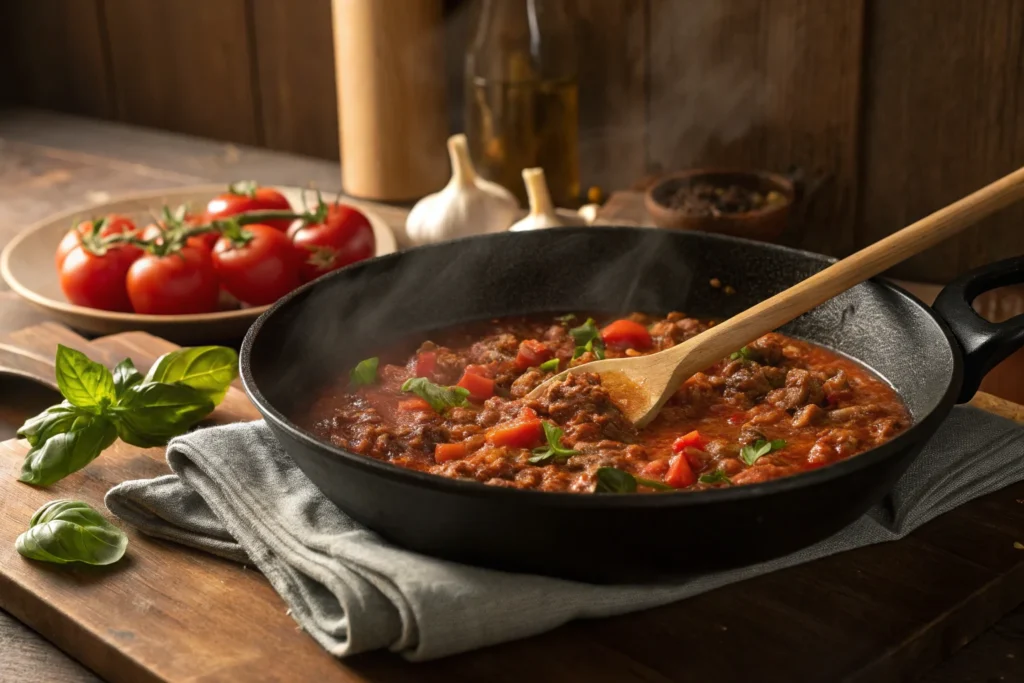
Ingredients for a Classic Meat Sauce
- 1 pound ground beef or Italian sausage (or a mix of both)
- 1 small onion, finely chopped
- 3 cloves garlic, minced
- 1 can (28 ounces) crushed tomatoes
- 1 can (15 ounces) tomato sauce
- 1 can (6 ounces) tomato paste
- 1 teaspoon dried basil
- 1 teaspoon dried oregano
- ½ teaspoon salt
- ½ teaspoon black pepper
- ¼ teaspoon red pepper flakes (optional)
- ½ cup water or beef broth
Step-by-Step Instructions
- Brown the Meat – Heat a large pan over medium heat. Add the ground beef or sausage, breaking it into crumbles as it cooks. Stir occasionally until browned, about 5 minutes.
- Sauté the Aromatics – Add the chopped onion and minced garlic to the pan. Cook for another 3 minutes until the onion softens.
- Add the Tomato Ingredients – Stir in the crushed tomatoes, tomato sauce, and tomato paste. Mix well to create a thick base.
- Season the Sauce – Sprinkle in basil, oregano, salt, black pepper, and red pepper flakes. Stir everything together.
- Simmer the Sauce – Pour in water or beef broth and bring the sauce to a gentle simmer. Reduce heat and let it cook uncovered for 30-40 minutes, stirring occasionally.
A well-simmered sauce makes a big difference in how to make lasagna taste authentic. If you have time, let it cook for up to an hour for deeper flavor.
Cooking the Lasagna Noodles
Noodles are the foundation of a great lasagna, so it’s important to cook them correctly. Whether you use traditional boiled noodles or oven-ready sheets, getting the texture right ensures your lasagna holds together when sliced.
Boiling Traditional Lasagna Noodles
- Boil a Large Pot of Water – Fill a pot with water, adding a generous amount of salt for flavor. Bring it to a rolling boil.
- Cook the Noodles – Add the lasagna noodles one by one, stirring gently to prevent sticking. Cook them al dente, usually 8-10 minutes.
- Drain and Cool – Remove the noodles from the pot and place them on a flat surface, such as a baking sheet, separating them with parchment paper to prevent sticking.
Using No-Boil (Oven-Ready) Noodles
If you want to save time, how to make lasagna without boiling noodles is a simple trick. No-boil noodles soften as they bake, absorbing moisture from the sauce.
- Ensure the sauce is slightly thinner – Extra liquid is needed for the noodles to cook properly.
- Fully cover each layer with sauce – Dry spots will leave some noodles undercooked.
- Increase baking time by 10 minutes if needed – Check for tenderness before serving.
For fresh pasta sheets, there is no need to pre-cook them. They can go straight into the lasagna as long as they are layered with enough sauce.
Mixing the Cheese Filling
A creamy, rich cheese layer is what makes lasagna so irresistible. The right blend of cheeses creates a smooth and slightly tangy contrast to the bold meat sauce.
Ingredients for Cheese Filling
- 15 ounces ricotta cheese
- 1 egg
- 1 cup shredded mozzarella cheese
- ½ cup grated Parmesan cheese
- ½ teaspoon salt
- ¼ teaspoon black pepper
- 1 teaspoon Italian seasoning
Steps to Make the Cheese Mixture
- Combine Ingredients – In a large bowl, mix the ricotta cheese, egg, mozzarella, Parmesan, salt, black pepper, and Italian seasoning. Stir until smooth and well blended.
- Check the Consistency – The mixture should be thick but spreadable. If it’s too stiff, add a splash of milk to loosen it.
- Taste and Adjust – For extra flavor, you can add a little garlic powder or fresh chopped basil.
This creamy filling adds the signature richness to how to make lasagna. Be sure to spread it evenly between the layers so every bite has a balanced taste.
Assembling the Lasagna
Now comes the fun part—building the layers. Proper layering is key to how to make lasagna that holds together and doesn’t collapse when sliced.
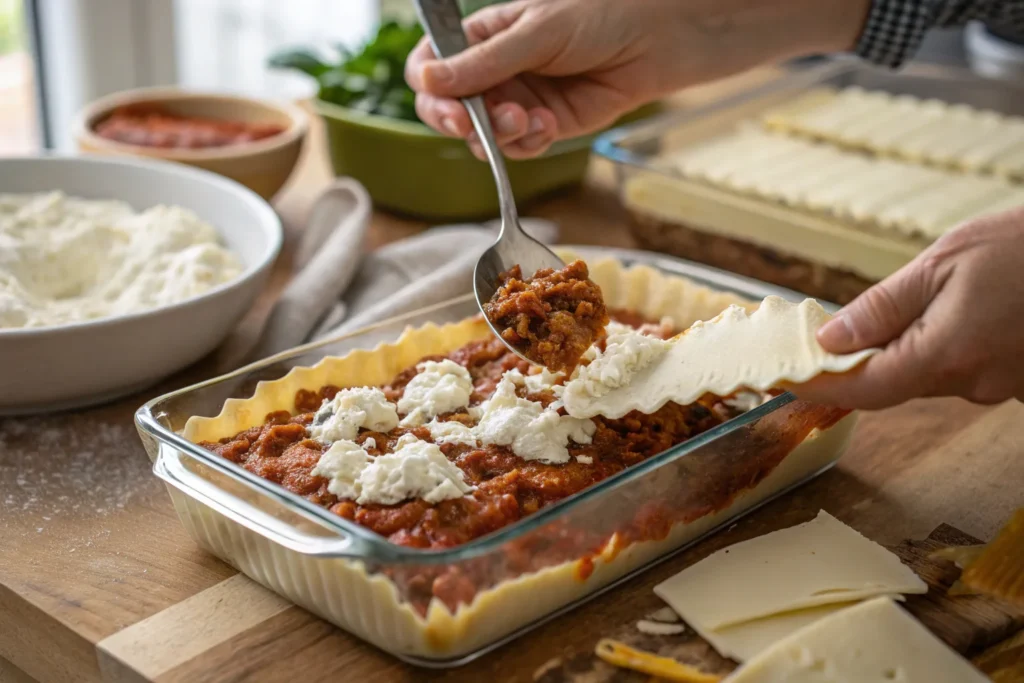
Layering Steps
- Preheat the Oven – Set it to 375°F (190°C) so it’s ready once the lasagna is assembled.
- Spread a Thin Layer of Meat Sauce – This prevents the bottom noodles from sticking.
- Lay Down the First Noodle Layer – Place noodles over the sauce, slightly overlapping them.
- Add a Cheese Layer – Spread an even layer of the ricotta mixture over the noodles.
- Spoon on More Meat Sauce – Make sure the sauce covers the cheese layer.
- Repeat Layers – Continue layering in the order of noodles, cheese, and meat sauce.
- Top with Mozzarella Cheese – Finish with a generous layer of shredded mozzarella for a bubbly, golden crust.
Most lasagna recipes have 3-4 layers, but you can adjust based on the depth of your baking dish.
Baking Instructions
The final step in how to make lasagna is baking it to perfection. The right temperature and baking time ensure the cheese melts beautifully while the flavors blend together.
How to Bake Lasagna
- Cover with Foil – Loosely tent aluminum foil over the dish to prevent the cheese from burning while the inside cooks.
- Bake for 30 Minutes – Keep it covered to trap moisture.
- Remove the Foil and Bake for 15 More Minutes – This allows the top layer to brown and bubble.
- Let It Rest – Once baked, let the lasagna sit for at least 10 minutes before slicing. This helps it set and prevents it from falling apart.
For a crispier top, broil the lasagna for the last 3-5 minutes of baking. Just keep an eye on it to prevent burning.
Mastering how to make lasagna step by step ensures you get the perfect balance of flavors and textures in every bite. Now that the lasagna is baked, it’s ready to be served and enjoyed. In the next section, we’ll cover variations, storage tips, and serving ideas.
Tips and Variations
Now that you know how to make lasagna step by step, let’s talk about ways to simplify the process and customize the dish to your taste. Whether you’re preparing it in advance or trying a meat-free version, a few small adjustments can make a big difference.
Make-Ahead and Freezing Tips
Lasagna is one of the best make-ahead meals because it stores well and tastes even better the next day. Preparing it in advance saves time, especially if you’re cooking for a busy weeknight or a special gathering.
How to Make Lasagna Ahead of Time
- Assemble but don’t bake – Prepare the lasagna up to the point of baking, then cover it tightly with plastic wrap and refrigerate for up to 24 hours.
- Increase baking time – Since the dish will be cold, bake it for an extra 10-15 minutes to ensure even heating.
- Store leftovers properly – Once cooked, lasagna can be refrigerated for up to 4 days in an airtight container.
Freezing Lasagna for Long-Term Storage
- Freeze before or after baking – Unbaked lasagna can be stored for up to 3 months, while baked lasagna lasts around 2 months in the freezer.
- Wrap it well – Use plastic wrap and aluminum foil to prevent freezer burn.
- Label with the date – This helps you keep track of how long it has been stored.
Reheating Frozen Lasagna
- For unbaked lasagna – Bake it straight from frozen at 375°F (190°C) for about 60-75 minutes, covered for the first 45 minutes.
- For baked lasagna – Thaw overnight in the fridge, then reheat in the oven at 350°F (175°C) for 30 minutes.
These tips make how to make lasagna more convenient, whether you’re planning meals ahead or saving leftovers for later.
Vegetarian and Other Variations
Not everyone enjoys traditional meat lasagna, and that’s okay. There are plenty of ways to customize the dish based on dietary needs or flavor preferences.
Vegetarian Lasagna
If you prefer a meat-free version, replacing the ground beef with vegetables can add just as much flavor.
- Use hearty vegetables – Mushrooms, zucchini, spinach, bell peppers, and eggplant make great substitutes for meat.
- Roast or sauté first – Cooking the vegetables before layering prevents excess moisture in the lasagna.
- Try a tomato-based or creamy sauce – A classic marinara works well, but a white béchamel sauce can add a rich, cheesy texture.
Gluten-Free Lasagna
If you’re avoiding gluten, there are several ways to adjust the recipe.
- Use gluten-free lasagna noodles – Many brands offer pasta made from rice, corn, or lentils.
- Swap noodles for vegetables – Sliced zucchini, eggplant, or sweet potatoes make great gluten-free layers.
Dairy-Free and Vegan Lasagna
For those avoiding dairy, a few ingredient swaps can create a delicious plant-based version.
- Use dairy-free cheese alternatives – Many brands offer plant-based ricotta, mozzarella, and Parmesan.
- Make a cashew-based ricotta – Blending soaked cashews with lemon juice and garlic mimics the texture of ricotta.
- Use a rich tomato sauce – A flavorful, well-seasoned sauce compensates for the lack of cheese.
Low-Carb Lasagna
If you’re watching carbs, there are ways to modify how to make lasagna without pasta.
- Replace noodles with vegetables – Zucchini or eggplant slices work well as substitutes.
- Use cottage cheese instead of ricotta – It’s lower in carbs and higher in protein.
- Limit tomato sauce – Some tomato sauces contain added sugars, so check the labels or make your own.
Experimenting with different variations ensures there’s a lasagna for everyone. Whether you’re making it ahead, freezing it, or switching up the ingredients, these tips help you create the perfect dish for any occasion.
Frequently Asked Questions
Even with a step-by-step guide, you might still have some questions about how to make lasagna. Whether you’re wondering about the ingredients, layering, or an easier way to prepare it, these common FAQs will help clarify the process.
What are the main ingredients in lasagna?
A classic lasagna recipe consists of three essential components: pasta, meat sauce, and cheese.
- Lasagna noodles – Traditional or no-boil varieties work well.
- Meat sauce – Made with ground beef or Italian sausage, tomatoes, garlic, onions, and seasonings.
- Cheese mixture – Ricotta, mozzarella, and Parmesan blended with eggs and seasonings.
Some recipes also include extras like spinach, mushrooms, or a creamy béchamel sauce for added texture. Choosing high-quality ingredients ensures the best flavor in your dish.
How to assemble lasagna step by step?
Layering Mini pasta recipes properly is key to making sure it holds its shape and tastes great. Follow these steps:
- Spread a thin layer of sauce on the bottom of a baking dish.
- Place the first layer of noodles, slightly overlapping them.
- Spread an even layer of ricotta mixture over the noodles.
- Add a layer of meat sauce, making sure it covers the cheese evenly.
- Repeat the layers (noodles, cheese, sauce) until the dish is full.
- Top with mozzarella cheese for a golden, bubbly crust.
Making sure each layer is evenly spread helps create a well-balanced Mafaldine with every bite.
How to make homemade lasagna easily?
If you want a quicker method for how to make Lasagnette, try these time-saving tips:
- Use no-boil noodles – These cook while baking, eliminating the need for boiling.
- Buy pre-made marinara sauce – A high-quality store-bought sauce saves time.
- Prepare in advance – Assembling the lasagna ahead of time allows flavors to develop and simplifies meal prep.
- Use a slow cooker – A crockpot version eliminates the need for oven baking.
These shortcuts allow you to enjoy homemade lasagna without spending hours in the kitchen.
What is the correct order to layer lasagna?
The layering order is crucial in how to make Lasagnette successfully. Stick to this pattern:
- Meat sauce – Always start with a layer of sauce to prevent sticking.
- Noodles – Lay them flat, slightly overlapping.
- Ricotta cheese mixture – Spread evenly to cover the noodles.
- Meat sauce again – Ensures each bite is flavorful.
- Repeat the layers – Continue until the dish is full.
- Mozzarella cheese on top – Creates a crispy, golden-brown crust when baked.
This method guarantees a well-structured Classic Mini pasta recipes that slices neatly and tastes amazing.
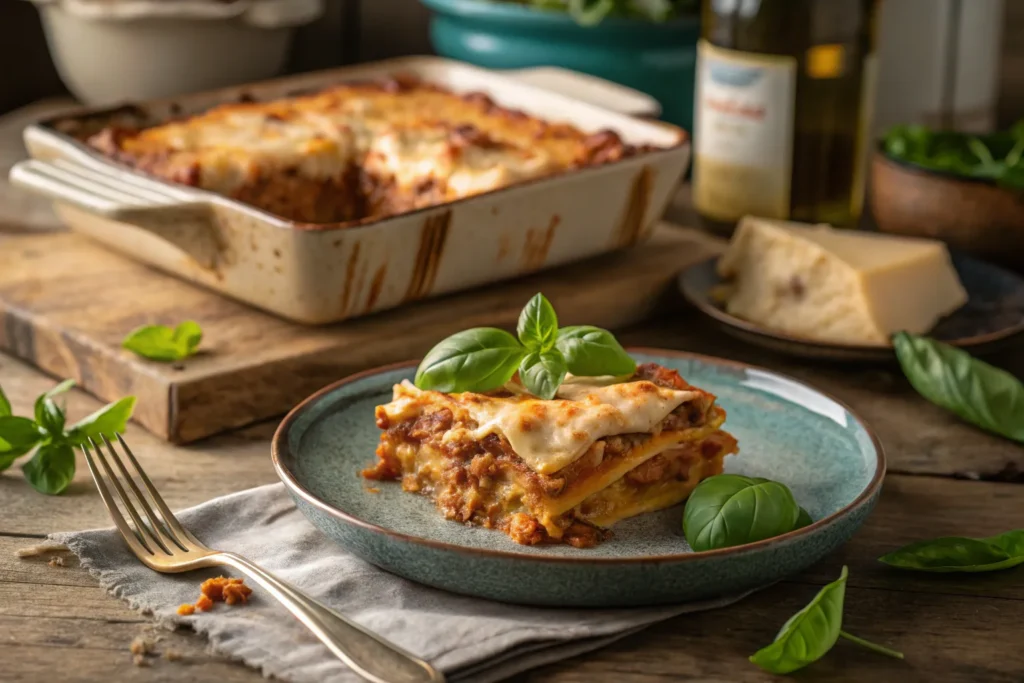
Conclusion
Now that you know how to make Mini pasta recipes, you can confidently prepare this delicious dish at home. From choosing the right ingredients to layering everything correctly, every step plays a role in creating a flavorful, satisfying meal.
Whether you stick to a traditional recipe or try a variation like vegetarian or gluten-free, Mini pasta recipes is always a crowd-pleaser. So grab your ingredients, follow the steps, and enjoy a homemade Mini pasta recipes that’s just as good—if not better—than any restaurant version.

